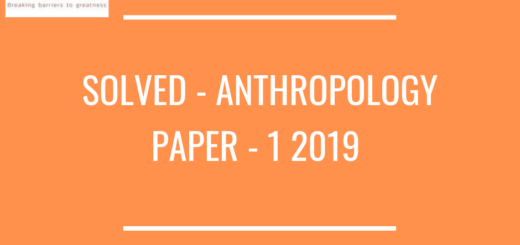Pseudo tribalism: Case study
Topic: Paper 2: Pseudotribalism, Tribe-caste continuum, Sanskritization, De-sanskritization, Social change in India
Pseudotribalism is a process in which the non tribals take up certain tribal features or pretend to be tribals in order to get social and economic benefits.
Reasons:
- Lower caste group specially among Hinduàin order to come out of oppression of caste hierarchy. Example- Lower caste in Nallamal Hills took up basket making and occasional hunting and tried to integrate into Chenchu society; Similarly untouchables of Nilgiri emulated Thodas. (Some anthropologist considers this to be sanscritization)
- Higher caste either through desanskritization or without giving up sanskritic tradition adoption tribal features. Generally to get economic benefits of being tribals.
- To gain rights over the forests and community resource
How:
- Following tribal way of life
- Getting fake ST certificate and claiming to be tribe in front of census official
- In Bastar region caste people worshiping abandoned tribal temples and living in abandoned tribal hamlets and practicing their customs
- Due to similar name of the caste group and a neighbouring tribe claim to be tribals. Korcha (caste) community which is synonymous of Yerukula tribe
Case study:
- A community may be Scheduled Tribe in one State and it may be Scheduled Caste in another State and same may be backward class or forward class in another State. For example, Lambadas or Banjaras or Sugalis are Scheduled Tribes in Andhra Pradesh, but they are classified as Scheduled Castes in Karnataka and Union Territory of Delhi and Backward Class in neighbouring Maharashtra.

- Entering tribal social network either through marriage or adopting a tribal family to gain rights over the forests and community resource> Example: in North east of Andra Pradesh and South Orissa non tribals enter the tribal institute called NESTHAM that play a role in conferring forest resource
- The Kammara caste group people (which is included in State B.C. list) who are blacksmiths in the plain areas, are also claiming as Kammaras of Agency tracts for the sake of cornering the reservation benefits of Scheduled Tribes. These two are quite distinct communities and they differ widely in their customs, traditions, habits and values.
- Korcha community which is synonymous of Yerukula tribe is in the list of Scheduled Castes in Karnataka State and in Andhra Pradesh, they are Scheduled Tribes. Similarly, ‘Goudu’ is Scheduled Tribe within the Agency tracts of Andhra Pradesh but they are not recognised as Scheduled Tribes in adjoining State of Orissa eventhough they are predominantly found in tribal areas of, Orissa State. This kind of anomalies lead to emigration of identical communities from a State where they are not Scheduled to a State where the same group is scheduled in order to utilise the benefits under the garb of Scheduled Tribes
- Pseudo tribalism due to similar name: Goudu of Agency tracts (Pastorals) are included in Scheduled Tribe list but Gowda, Gamalla, Goundla or Ediga of plain areas who are traditional toddy tappers are included as Backward Classes. Both communities are distinct and different.
- In view of identical nomenclatures, – some of the plain people belonging to Kapu, Reddi, Thoti, Bagata, Mannervarlu, Samantha or Samantiya, Benatho Oriya or Bentho Oriya, Holva, Boya Valmiki, Pala Ekiri etc. communities are managing to produce Scheduled Tribe Certificates.
- Some of the people belonging to Pala Ekiri caste are styling themselves as Erukula and are producing bogus tribal certificates.
- Some of the communities, who even without any kind of identical nomenclature, are also fraudulently claiming as if they belong to some of the sub-divisions mentioned under certain generic names or main group. For example, Mannevarlu under Kolam, Bentho Oriya under Kotia, Lingadhari Koya under Koya etc., even though they do not actually belong to these sub-divisions.
For more case study and articles related to anthropology: Click here
For UPSC anthropology preparations: click here
For UPSC anthropology videos: Click here












